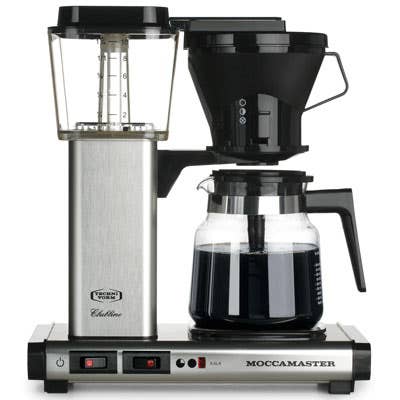
A Fine Drip
Across the country, specialty coffee roasters are turning more and more people on to their carefully sourced, ultrafresh, delicious brews. Now, as these coffees fetch increasingly higher prices, it's more important than ever to choose the right method for preparing your morning cup at home. The hundredth anniversary of the coffee filter (see ** Law of Gravity) got us thinking about the classic drip method, which is known to produce coffee that's clean and nuanced, with a luxurious mouth-feel. James Freeman, owner of the Bay Area's celebrated ** Blue Bottle Coffee shops, calls drip coffee a humble yet elegant version of the drink. After we talked with Freeman and other experts, though, one thing became clear: when it comes to drip coffee, the hardware really does make a difference. As Freeman says, "There's drip, and then there's drip." Below are seven coffeemakers (and one helpful accessory) that will make the most of your splurge-worthy beans.
MANUAL
Coffee aficionados agree that manual brewing systems are preferable to automatic ones because they allow for greater control. For brewing an optimal cup, the water must be heated to approximately 200 degrees Fahrenheit and distributed evenly over the grounds; both variables can be inconsistent with automatic coffeemakers. There's also the aesthetic appeal of brewing your coffee by hand, says Peter Giuliano, Director of Coffee and Co-Owner of North Carolina's Counter Culture Coffee:"Brewing coffee in a machine is a little like cooking an omelette in a microwave: it might save time, but the product is completely different."
Hario Ceramic Cone
($19)
Drip coffee at its simplest and least expensive. Just insert a filter (we recommend a neutral-tasting, hemp-based paper version) into the cone, set the cone on a mug, andpour hot water over the grounds. We prefer the ceramic material to the standard plastic because it retains heat better, is easier to clean, and won't impart a stale odor to your cup over time.
Chemex
($35.90 for the 6-cup flask)
In 1941 the chemist Peter J. Schlumbohm invented the hourglass-shaped Chemex, whose design is so admired that the device is included in the permanent collection at the Museum of Modern Art. It's not just pretty to look at, either. The Chemex's cone shape and extra-thick paper filters make it impossible for even the smallest amount of coffee grounds to slip into your cup. Though it's necessary to pour the water over the grounds in a slow, circular stream, the reward for the added effort is an especially clean-tasting cup.
Hario Nel Drip
($39.95 with wood-neck dripper pot)
In the Japanese Nel drip, a flannel filter hangs from a wire ring over a thermal or glass pot. Blue Bottle's Freeman says the Nel yields coffee with a "brooding, autumnal flavor." Some experts warn that it can be challenging to maintain the freshness of the Nel filter, but devotees keep the flannel clean by scrubbing it regularly with a brush before letting it rest in boiling water. Another tip: store the filter in a cup of water in the fridge overnight.
**
Yama Siphon Brewer
($90.00 with refillable butane burner)
A butane burner powers this complex system of stacked glass orbs, which looks as if it belonged in a high-school chemistry lab rather than a high-end cafe. Heat-generated suction draws the water from the lower globe into the upper one, where it combines with coffee grounds before dripping back down through a cloth mesh filter. Although David Latourell, an adviser for the Chicago-based Intelligentsia Coffee, admits that the Siphon, which takes three minutes to brew a pot, is a "tricky bugger," he appreciates the subtle weightiness of the coffee it produces.
Breville Variable-Temperature Kettle
($149.95)
Hitting the ideal near-boiling point with manual systems can be tricky if you're relying on a standard teapot and burner; home baristas will appreciate the convenient temperature setting of this attractive stainless kettle, which can be used with any of the coffeemakers listed above.
AUTOMATIC
Giuliano of Counter Culture stresses that "the simple elegance of hand-brewed coffee is part of the enjoyment," he and other do-it-yourself advocates admit that certain automatic coffeemakers also turn out coffee that's pretty darned good.
Technivorm Moccamaster KBT741
($265)
The only automatic drip coffeemaker certified by the Specialty Coffee Association of America the formidably named Dutch system the Technivorm, gets votes for its ability to reach the proper brewing heat consistently, unlike other machines, which brew for longer times at lower temperatures, causing overextraction and an unpleasant, burnt flavor.
Capresso MT600
($139.99)
This attractive, modern machine, which will be released in December of this year, has all the features that coffee geeks would expect from a high-end device, including a programmable timer, a permanent gold filter, and a drip stop that allows you to pour coffee midbrew. Its stainless-steel body prevents odor absorption, and it boasts a built-in water filter, which ensures that every cup is free of flavor-killing chlorine.
Clover
(approximately $11,000)
When first released, the Clover, which makes each cup individually, was quickly deemed the Ferrari of coffeemakers because of its unique ability to allow baristas to set the ideal temperature and extraction time based on the type of bean being used. (For example, a darker roast benefits from a slightly lower temperature and a shorter extraction time, while a bean that's been roasted lightly shines after extended contact with extra-hot water.) Even if the Clover's ridiculously steep price (and limited availability) means that few people will ever count it among their kitchen appliances, coffee diehards can sample pristine, Clover-brewed joe at such cafes as Intelligentsia Coffee in Chicago and LA, New York's Cafe Grumpy and Gainesville, Florida's Volta Coffee. Starbucks, which bought the technology in 2008, also features the machines in some locations.
**
Keep Reading
Continue to Next Story










